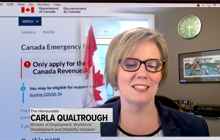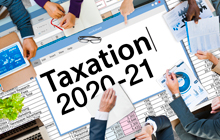Tax preparers and professionals: Here’s what you need to know for the 2021 tax-filing season

Canada Revenue Agency on planning ahead, what’s new for upcoming tax season
OTTAWA, Feb. 12, 2021 – This year, the COVID-19 pandemic may have affected the tax-filing situations of your clients. It may also affect the way you usually interact with them to file their income tax and benefit returns. Over 30 million returns were filed last season, and over 17 million were electronically filed by tax preparers and tax professionals. The Canada Revenue Agency (CRA) wants to help you make sure your clients are prepared to file their returns this year.
Planning ahead this tax-filing season
If your clients choose to file a paper return, the COVID-19 pandemic may affect their ability to file a return, slow down their assessment, or affect their ability to receive their refund, benefit or credit payments. This year, it is important for your clients to file their returns electronically and as soon as possible, because they may be entitled to a refund, benefits, or credits. Online filing opens on February 22, 2021. If your clients do submit a paper return, it may take 10-12 weeks for the CRA to issue them their assessment due to on-site processing limitations in tax centres.
Your clients should receive most of their slips and receipts by the end of February. If they don’t receive their slips, they may be able to get them through My Account. As you are no doubt aware, tax slips and other tax-related information are also available in Auto-fill my return, a secure service in certified tax software.
If you or your clients want to learn more, the CRA’s Get Ready page has information about online filing, deadlines, and other helpful links.
Signing up for direct deposit
Your clients now have more options to sign up for direct deposit because more financial institutions began to offer CRA direct deposit through their websites as of April 2020. As of November 2020, more than 3 million individuals have enrolled for direct deposit through their financial institution.
Please make sure your clients are aware of this information and encourage them to sign up so they can get their refunds faster and avoid delays.
Filing for recipients of COVID-19 emergency benefits
The CRA and Service Canada processed more than 27 million Canada Emergency Response Benefit (CERB) applications, totaling more than $81 billion in payments to Canadians. The CRA also processed more than 2 million Canada Emergency Student Benefit (CESB) applications that totaled more than $2 billion in payments.
If your clients received CERB, CESB, Canada Recovery Benefit (CRB), Canada Recovery Sickness Benefit (CRSB), or Canada Recovery Caregiving Benefit (CRCB) payments, you need to include the total amount they received on their return. For any such payments, they will receive a T4A (for benefits issued by the CRA) and/or a T4E (for benefits issued by Service Canada) tax slip in the mail with the information they need to enter on their return. The slips can also be viewed online in My Account and Represent a Client as of February 8, 2021. Residents of Quebec will receive both a T4A and RL-1 slip from the CRA, however, the RL-1 slip will not be available for viewing in My Account.
The CRA recognizes that receiving these slips might generate questions for Canadians. Those who believe they received a T4A or a RL-1 by mistake or believe there may be discrepancy with the information provided on these slips should contact the CRA.
The CRA wants to add that some provinces or territories may have sent out pandemic related payments that are considered taxable income. These amounts should be included on your client’s tax return.
If your clients received the CERB or CESB, no tax was withheld when payments were issued. If your clients received the CRB, CRSB, or CRCB, 10% tax was withheld at source. For Quebec residents who received the CRB, CRSB, and CRCB, 5% of the tax withheld will be reported on the T4A slip and the other 5% will be reported on the RL-1 slip.
Keep in mind that these benefits are taxable and that your clients may owe no tax, owe tax, or be entitled to a refund when filing their return depending on how much income they earned from all sources, and deductions and credits they are entitled to claim in 2020.
If you have clients whose income is normally exempt from tax, their COVID-19 benefits may also be exempt from tax. If they received CRB, CRSB or CRCB payments in 2020, they can claim a refund of the 10% (5% for Quebec residents) tax that was withheld on these payment by filing a 2020 tax return.
Your clients may have other impacts filing their return that are specific to the COVID-19 emergency benefit payments, or if they are a resident of Quebec.
Providing additional income support to Canadians
The Government of Canada has indicated from the outset that there would be no penalties or interest in cases where CERB needs to be repaid. However, we recognize that, for some individuals, repaying the CERB could present a significant financial hardship. For this reason, we will give Canadians more time and flexibility to repay based on their ability to pay. We will work with impacted individuals on a case-by-case basis. There is no deadline to repay COVID-19 emergency benefit payments.
If your client mistakenly received COVID-19 emergency benefit payments, or their situation has changed since they first applied for one these benefits, they can repay the CRA via My Account, online banking, or mail.
Newly announced on February 9, 2021, targeted interest relief is being provided to Canadians who received COVID-related income support benefits. Once individuals have filed their 2020 income tax and benefit return, they will not be required to pay interest on any outstanding income tax debt for the 2020 tax year until April 30, 2022.
Self-employed individuals who applied for the CERB and would have qualified based on their gross income will not be required to repay the benefit, provided they also met all other eligibility requirements. The same approach will apply whether the individual applied through the CRA or Service Canada.
Some qualifying self-employed individuals whose net self-employment income was less than $5,000 may have already voluntarily repaid the CERB. The CRA and Service Canada will return any repaid amounts to impacted individuals.
Payment arrangement parameters have been expanded to give Canadians more time and flexibility to repay based on their ability to pay. Individuals who cannot make a payment in full are advised to contact the CRA to make a payment arrangement.
Do not risk having benefits interrupted
Doing taxes on time is the best way to ensure your clients are entitled to benefit and credit payments, like the Canada child benefit (CCB), the Old Age Security (OAS) pension payments, and the goods and services tax/harmonized sales tax (GST/HST) credit, are not interrupted. Even if your clients owe tax, they should not risk having their benefits interrupted by not filing. If they cannot pay their balance owing, the CRA can work with your clients on a payment arrangement.
Protection from scams and fraud
It is important for your clients to protect themselves from scams, and to know when and how the CRA might contact them. The Slam the scam webpage provides information about how people can protect themselves from fraud and understand the ways in which the CRA will be in touch.
The CRA also provides information to Canadians on securing their CRA accounts. As fraud prevention measures, we encourage them to:
- Use unique and complex passwords. Always use unique passwords for your CRA and online banking accounts. Do not reuse the same password for different systems.
- Create a PIN. We suggest you set up a personal identification number (PIN) in My Account or with the help of one of our call centre agents, to help confirm your identity for future calls with the CRA.
- Sign up for email notifications. We recommend you enable “Email notifications”. This service notifies taxpayers by email if their address or direct deposit information have been changed on CRA records. These notifications can act as an early warning for potential fraudulent activity.
- Monitor your account for suspicious activity. Check your online CRA accounts regularly for any suspicious activity. This includes unsolicited changes to your address and direct deposit information, or benefit applications made on your behalf.
What’s new for 2021
Additional call agents to further increase call centre capacity – Throughout COVID-19, the CRA has seen a significant increase in call volumes. To help manage this, the 2020 Fall Economic Statement allocated additional funding to the CRA for call centre operations.
Using this investment, the CRA has hired additional agents who will help with increased call volumes. It has also contracted a third-party service provider to assist with client service capacity issues. These agents will be able to answer general enquiries about emergency benefits, but they will not have access to taxpayers’ personal information.
New automated callback service – This new service lets callers ask for a callback instead of waiting on hold. Callers on the individual tax enquiries, benefits enquiries, and business enquiries lines may be given the option of a callback when wait times reach a certain length. The new automated callback service is easy to use, secure, and helps save callers time on the phone.
Extended call centre hours – Leading up to and throughout tax-filing season, the CRA's Individual enquiries line is open Monday to Friday from 9am to 9pm local time, and our extended Saturday hours will be 9am to 5pm as of February 27th.
Immediate Support for Families with Young Children – In the Fall Economic Statement, the Government announced support for families with young children for 2021. To provide immediate support for families with young children, the Government proposes to provide, in 2021, four tax-free payments of $300 per child under the age of six to families entitled to the Canada child benefit (CCB) with family net income equal to or less than $120,000, and $150 per child under the age of six to families entitled to the CCB with family net income above $120,000.
Individuals who are entitled to receive a CCB payment in January, April, July and October, will receive these payments for children under the age of six. The first two payments would be based on the family’s net income in 2019 while the last two payments will be based on the family’s net income in 2020. Parents must file their tax returns for these years to receive all four payments.
Home office expenses – If you have clients who worked more than 50% of the time from home for a period of at least four consecutive weeks in 2020, they may be eligible to claim a deduction for home office expenses in the 2020 tax year.
Multi-factor authentication – The CRA has introduced a second layer of authentication that gives CRA login services users more security and ensures only they can login to their account. After enrolling, users will need to enter a passcode that is sent to them via text or voice message each time they access their online CRA account.
Canada training credit – If you were at least 26 and less than 66 years old at the end of 2020 and you have a Canada training credit limit for 2020 on your latest notice of assessment or reassessment for 2019, you may be eligible to claim this refundable tax credit for up to half of your eligible tuition and other fees paid to an eligible educational institution in Canada for courses you took in 2020, or fees you paid to certain bodies for an occupational, trade or professional examination taken in 2020.
Digital news subscription tax credit – For the 2020 to 2024 tax years, your clients may be able to claim a non-refundable tax credit if they paid for a qualifying digital news subscription with a qualified Canadian journalism organization.
Canadian journalism labour tax credit – For 2019 and later tax years, if your client is a qualifying member of a partnership, they may be able to claim this new, refundable credit. The partnership must be a qualifying journalism organization and must allocate the credit to your client.
Trust accounts registration online – The CRA is developing a new registration service that will allow most trusts to apply for a trust account number online. The new service is expected to be available in February 2021, and will be available through My Account, My Business Account, and Represent a Client.
Removal of drop boxes – Due to COVID-19, drop boxes have been closed at CRA offices except the Sudbury, Winnipeg, and Jonquiere Tax Centres. If you need to mail your clients’ tax return, please send it to their nearest tax centre.
Published by Canadian Accountant from media advisory posted by the Canada Revenue Agency. Image by rawpixel.com.







(0) Comments